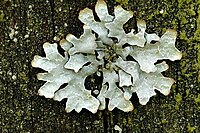
Photo from wikipedia
Data on the vertical distribution of radionuclides in the soil is necessary to fully understand the radioecological situation around ecosystems, give predictive estimates to how safe crop products are and… Click to show full abstract
Data on the vertical distribution of radionuclides in the soil is necessary to fully understand the radioecological situation around ecosystems, give predictive estimates to how safe crop products are and justify a rehabilitation strategy for radioactively contaminated areas. A study was conducted to investigate the vertical distribution of radionuclides in soils of the former Semipalatinsk Test Site (STS) territory beyond its testing sites, that is, in areas in which no nuclear weapons or nuclear effects of radiological warfare agents were tested. Soil was sampled layerwise all over the Semipalatinsk Test Site down to 30 cm deep at a 5-cm spacing. Most of high activity concentrations of radionuclides all over the study area were detected in the 0–5 cm soil layer. Activity concentrations of the major man-made radionuclides were determined in soil samples collected by γ-, β and α-spectrometry. As a result, ranges of activity concentrations of 137Cs, 241Am, 90Sr and 239+240Pu were determined in 0–5, 5–10, 10–15, 15–20, 20–25, 25–30 cm soil layers. In the conventionally ‘background’ area, the 0–5 cm soil layer, on average, contains (the percentage of total activity concentration across the soil profile depth): 137Cs– 83%, 239+240Pu– 87% and 90Sr– 38%. For the 1953 plume, these values were 92%, 83% and 73%, respectively. Values for the 1951 plume in the 0–5 cm soil layer were: 137Cs– 93%, 239+240Pu– 93% and 90Sr– 59%. The minimum concentration of radionuclides are observed 20–30 cm deep in all areas studied. 90Sr is the most mobile radionuclide from the perspective of its ability to travel deep down the soil. The study found out that the nuclide vertical migration rates downward in soils based on detected activity were as follows (in descending order): 90Sr– 137Cs– 239+240Pu– 241Am. Coefficients that determine the ratio of the activity concentration of the radionuclide in the 0–20 and 0–30 cm soil cover layers to that of this radionuclide in the 0–5 cm topsoil were calculated. These coefficients enable to estimate the radionuclide inventory at each soil sampling point from their activity concentration in the 0–5 cm soil layer.
Journal Title: PLOS ONE
Year Published: 2023
Link to full text (if available)
Share on Social Media: Sign Up to like & get
recommendations!